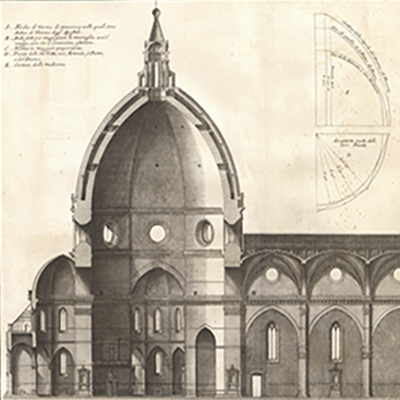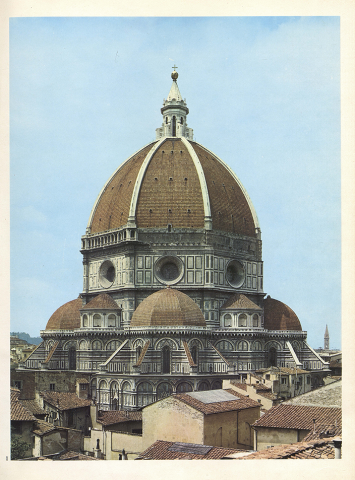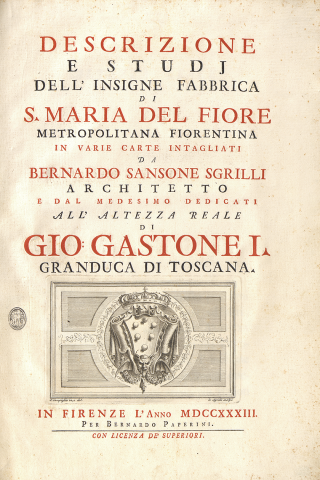
- 600 Years in the Shadow of the Dome
- 1st Floor Exhibit Cases, Hunt Library
- Ongoing
The Cathedral of Florence, Italy and its Brunelleschi Dome may be seen to represent the physical and social environment of Florence much like the US Steel Building does for the city of Pittsburgh. “600 Years in the Shadow of the Dome,” the latest exhibit on view at Hunt Library, explores these relationships and the power and allure of Florence’s fantastic dome.
 “Each building is emblematic of the culture and architecture of its time and place,” said University Libraries Principal Librarian and Architecture Archivist Martin Aurand, who curated the exhibit. “The church and dome in Florence are replaced by industry and skyscraper in Pittsburgh. Each building is part of everyday experience because it can be seen from vantage points across its city and beyond, and dominates its city visually. Each locates its city exactly and when you see it, you know where you are.”
“Each building is emblematic of the culture and architecture of its time and place,” said University Libraries Principal Librarian and Architecture Archivist Martin Aurand, who curated the exhibit. “The church and dome in Florence are replaced by industry and skyscraper in Pittsburgh. Each building is part of everyday experience because it can be seen from vantage points across its city and beyond, and dominates its city visually. Each locates its city exactly and when you see it, you know where you are.”
Construction of the cathedral of the Duomo di Firenze began in 1296, taking 140 years to complete. An architectural design competition was held for the completion of an octagonal dome in 1418, and architect Filippo Brunelleschi received the commission. Work on the dome began in 1420 and was completed in 1436. In time the Brunelleschi Dome became a focal point for the city of Florence and serves as a hallmark in architectural and urban history; something that has captured Aurand’s imagination for years.
“I visited the Cathedral in 1997 and remember the building’s strong presence in the Piazza del Duomo and how it commands views down neighboring streets,” Aurand recalls. “I remember how it dominates the city when seen from afar, and sketched and photographed it like many other visitors have done. I am interested in how the Florence Cathedral serves as a focal point for popular and touristic attention as well as for scholarly investigation. I am also interested in its role as an urban landmark, and how all of these strands tie into Pittsburgh.”

The exhibit showcases the urban roles shared by Florence and Pittsburgh by juxtaposing the Duomo with that of the Allegheny Court House and US Steel Building. Scholarship and documentation of the Duomo are examined, including a lively if contentious exchange between two Pittsburgh scholars whose letters appeared in the leading scholarly journal “Art Bulletin.” Also on display are reproductions of Giovan Battista Nelli’s acclaimed set of Duomo drawings from 1688, which were published in “Descrizione e studj dell’ insigne fabbrica di S. Maria del Fiore” in 1733. A rare edition of this title is housed in the Fine and Rare Book Room located on the 4th Floor of Hunt Library and is available to view by request.
As Architecture Archivist, Aurand oversees the vast repository of architectural drawings and records housed in the Carnegie Mellon University Architecture Archives, which focuses on the architects and architecture of Pittsburgh, including the Carnegie Mellon University campus. Aurand also serves as liaison librarian to the School of Architecture for the University Libraries. He is the author of two books: “The Spectator and the Topographical City” and “The Progressive Architecture of Frederick G. Scheibler, Jr.,” both published through University of Pittsburgh Press. He is also the author and contributor to numerous articles and web-based resources on Pittsburgh architects and architecture.
